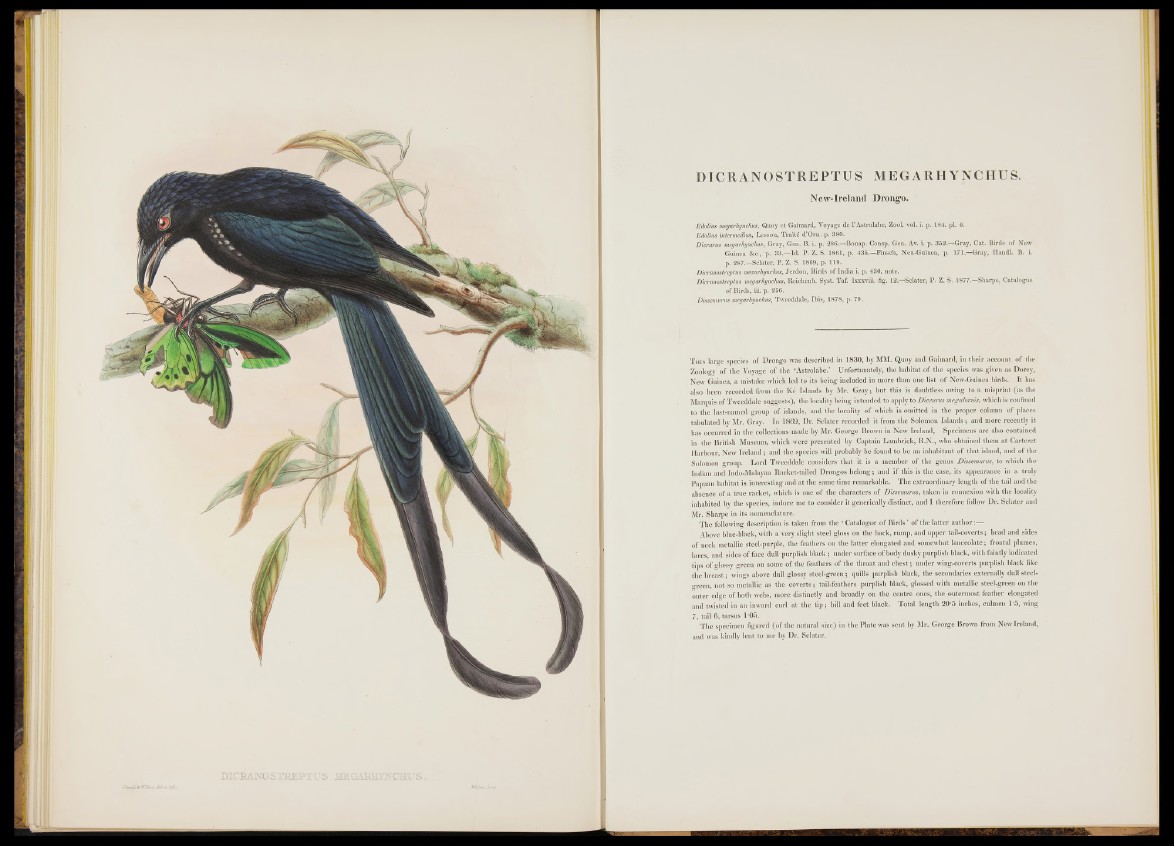
DICRANOSTREPTUS MEGARHYNCHUS .
New-Ireland Drongo.
Edolius megarhynchus, Quoy et Gaimard, Voyage de l ’Astrolabe, Zool. vol. u p .,184. pi. 6.
Edolius intermedins, Lesson, Traité d’Orn. p. 380.
Dicrurus megarhynchus, Gray, Gen. B. i. p. 286.—Bonap. Consp. Gen. Av. i. p. 352.—Gray, Cat. Birds o f New
Guinea &c., p. 33.—Id. P. Z. S. 1861, p. 435.—Finsch, Neu-Guinea, p. 171.—Gray, Handl. B . i.
p. 287.^Sclater, P. Z. S. 1869, p. 119.
Dicranostreptus mezorhynchus, Jerdon, Birds o f India i. p. 430, note.
Dicranostreptus megarhynchus, Reichenb. Syst. Taf. lxxxviii. fig. 12.—Sclater, P. Z. S. 1877".—Sharpe, Catalogue
o f Birds, iii. p. 256.
Dissemurus megarhynchus, Tweeddale, Ibis, 1878, p. 79.
T h is large species of Drongo was described in 1830, by MM. Quoy and Gaimard, in their account of the
Zoology o f the Voyage of the ‘Astrolabe.’ Unfortunately, the habitat of the species was given as Dorey,
New Guinea, a mistake which led to its being included in more than one list of New-Guinea birds. It has
also been recorded from the Ke Islands by Mr. Gray; but this is doubtless owing to a misprint (as the
Marquis o f Tweeddale suggests), the locality being intended to apply to Dicrurus megalornis, which is confined
to the last-named group of islands, and the locality o f which is omitted in the proper column o f places
tabulated by Mr. Gray. In 1869, Dr. Sclater recorded it from the Solomon Islands; and more recently it
has occurred in the collections made by Mr. George Brown in New Ireland, Specimens are also contained
in the British Museum, which were presented by Captain Lambrick, R.N., who obtained them at Carteret
Harbour, New Ireland; and the species will probably be found to be an inhabitant o f that island, and of the
Solomon group. Lord Tweeddale considers that it is a member of the genus Dissemurus, to which the
Indian and Indo-Malayan Racket-tailed Drongos belong; and if this is the case, its appearance in a truly
Papuan habitat is interesting and at the same time remarkable. The extraordinary length o f the tail and the
absence o f a true racket, which is one o f the characters of Dissemurus, taken in connexion with the locality
inhabited by the species, induce me to consider it generically distinct, and I therefore follow Dr. Sclater aud
Mr. Sharpe in its nomenclature.
The following description is taken from the ‘ Catalogue o f Birds ’ o f the latter author
Above blue-black, with a very slight steel gloss on the back, rump, and upper tail-coverts; head and sides
of neck metallic steel-purple, the feathers on the latter elongated and somewhat lanceolate; frontal plumes,
lores, and sides o f face dull purplish black; under surface o f body dusky purplish black, with faintly indicated
tips of glossy green on some o f the feathers o f the throat and chest; under wing-coverts purplish black like
the breast; wings above dull glossy steel-green; quills purplish black, the secondaries externally dull steel-
green, not so metallic as the coverts; tail-feathers purplish black, glossed with metallic steel-green on the
outer edge o f both webs, more distinctly and broadly on the centre ones, the outermost feather elongated
and twisted in an inward curl at the tip ; bill and feet black. Total length 20*5 inches, culmen 1-5, wing
7, tail 6, tarsus I ’05.
The specimen figured (o f the natural size) in the Plate was sent by Mr. George Brown from New Ireland,
and was kindly lent to me by Dr. Sclater.